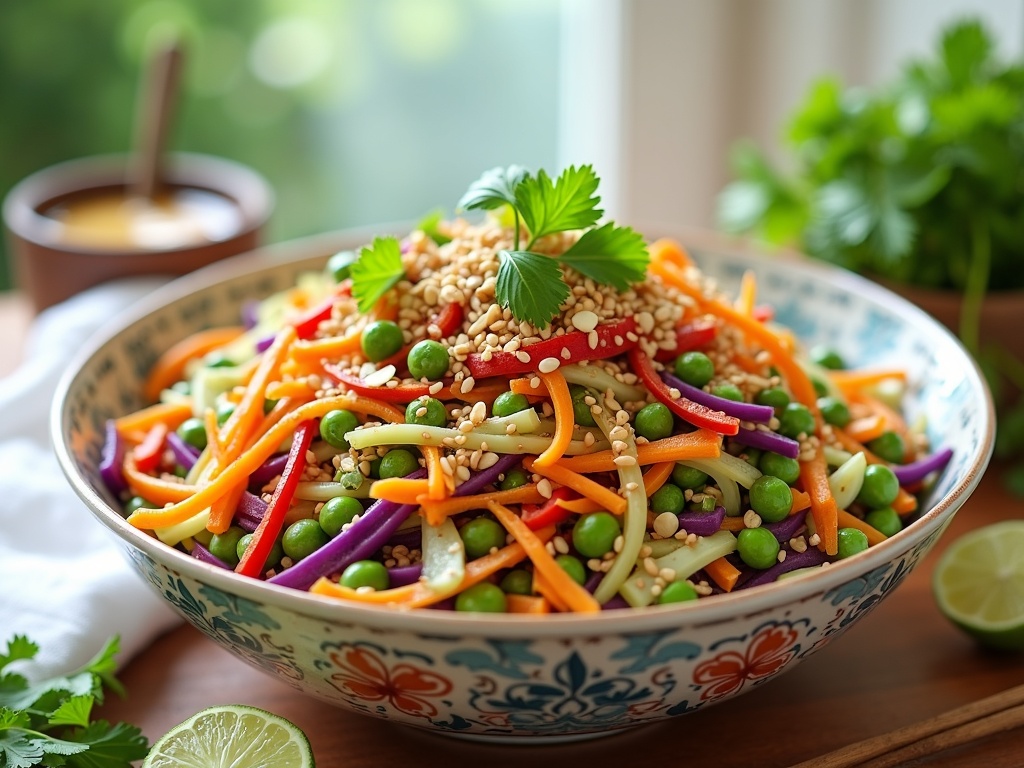Asian slaw delivers a vibrant alternative to traditional coleslaws with its perfect harmony of sweet, tangy, and umami flavors served in a light, vinegar-based dressing instead of heavy mayonnaise. The combination of crisp vegetables like cabbage, carrots, and bell peppers creates a versatile dish that maintains its texture for days, making it ideal for meal prep and outdoor gatherings.
Find In This Article
Key Takeaways
- Asian slaw features a balanced flavor profile combining rice vinegar, sesame oil, soy sauce, and fresh ginger for distinctive Asian flavors.
- The textural experience comes from julienned vegetables and crunchy toppings like toasted sesame seeds, sliced almonds, or crushed peanuts.
- Unlike mayo-based slaws, Asian slaw’s vinegar-based dressing keeps vegetables crisp longer and makes it food-safe for outdoor serving.
- The slaw can be prepared ahead by storing vegetables and dressing separately until serving time for maximum freshness.
- Beyond being a side dish, Asian slaw works wonderfully in Buddha bowls, fish tacos, as a topping for sandwiches, or as a base for protein.
What Makes This Slaw Special
Asian slaw stands out from traditional coleslaw with its vibrant flavors and crisp textures. I’ve found that the magic of this dish lies in its perfect balance of sweet, tangy, and umami elements that dance on your taste buds with every bite. Unlike heavy, mayo-laden slaws that can feel overwhelming, Asian slaw offers a refreshing alternative that complements nearly any meal.
A Symphony of Flavors and Textures
The beauty of Asian slaw comes from its unique flavor profile. Each forkful delivers a harmonious blend of sweetness from ingredients like honey or mirin, tanginess from rice vinegar, and that distinctive umami depth from soy sauce or sesame oil. I love how these flavors merge together, creating something far more exciting than the sum of their parts.
The textural experience is equally impressive. The slaw features:
- Crisp cabbage (purple and green varieties) that maintains its crunch
- Julienned carrots that add natural sweetness and color
- Fresh bell peppers for a juicy crunch
- Snap peas or edamame for extra dimension
- Crunchy elements like toasted sesame seeds or slivered almonds
What truly sets Asian slaw apart is its lightness. Unlike traditional creamy coleslaws that rely heavily on mayonnaise, Asian-inspired slaws typically feature vinegar-based or oil-based dressings. This lighter approach means the vegetables remain crisp longer, and the dish feels cleaner on the palate. The absence of heavy mayo makes it perfect for hot summer days when you want something substantial yet refreshing.
I’ve found Asian slaw to be remarkably versatile too. It pairs beautifully with beef dishes and grilled meats, adding a bright contrast to richer flavors. It works wonderfully alongside fried rice or noodle dishes, providing that necessary fresh element to balance out the meal.
For practical purposes, this slaw shines in several contexts. At BBQs, it offers a welcome alternative to heavier side dishes and stands up well to outdoor serving conditions. For picnics, its vinegar-based dressing makes it a safer option than mayo-based salads that can spoil quickly in warm weather.
Perhaps most impressively, Asian slaw excels at meal prep. Unlike many prepared salads that wilt within hours, a properly made Asian slaw can maintain its texture and flavor for days in the refrigerator. I often make a large batch on Sunday to enjoy throughout the week as a quick side dish or as a base for Thai-inspired lunch bowls topped with protein.
The visual appeal shouldn’t be overlooked either. The vibrant colors from purple cabbage, orange carrots, red peppers, and green edamame create a feast for the eyes before you even take your first bite. This makes Asian slaw an ideal choice when presentation matters, whether for casual gatherings or more formal occasions.
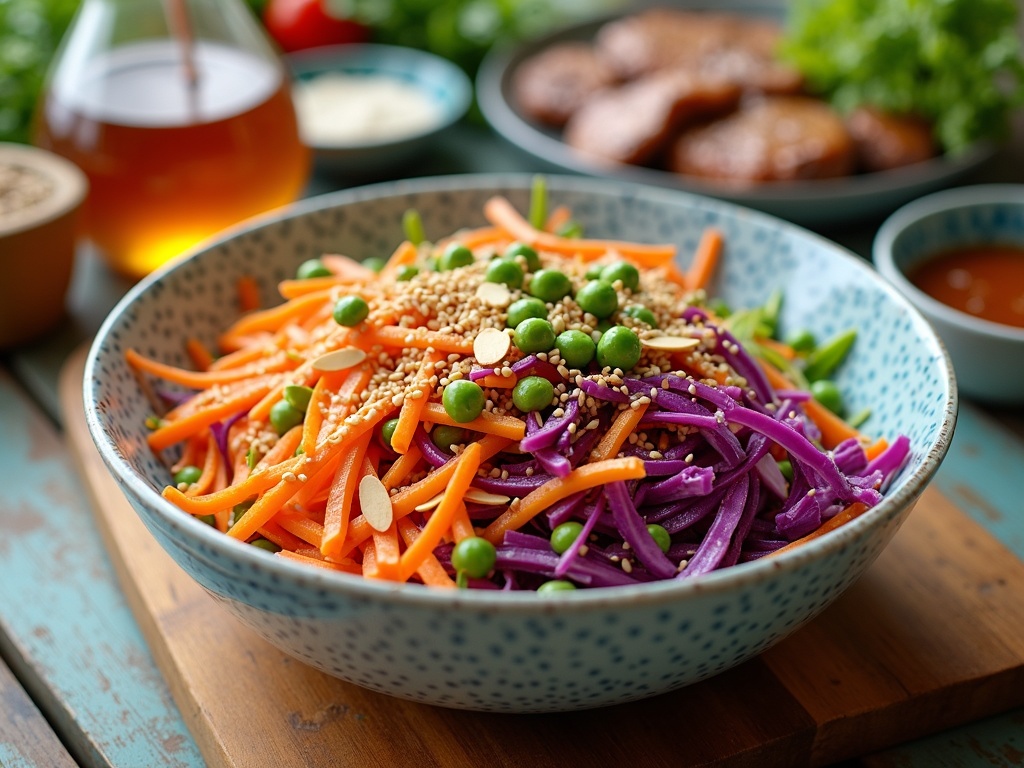
Fresh Ingredients You’ll Need
I’ve found that the beauty of Asian-inspired salads lies in their vibrant colors and crisp textures. The ingredients for an authentic Asian slaw are straightforward yet impactful, creating a dish that’s both visually stunning and packed with flavor.
Core Vegetables
The foundation of any great Asian slaw starts with cabbage – both green and purple varieties. The green cabbage provides a mild, slightly sweet crunch, while purple cabbage adds a gorgeous pop of color and a slightly peppery note. I julienne carrots to add natural sweetness and that distinctive orange hue that brightens the entire dish.
Sliced red bell peppers bring not only vibrant color but also a sweet crunch that complements the cabbage perfectly. I always include chopped green onions for their mild bite that cuts through the sweetness of the other vegetables.
Fresh cilantro leaves are non-negotiable in my Asian culinary creations. They add a distinctive fresh, citrusy flavor that elevates the entire slaw. If you’re not a fan of cilantro, Thai basil or mint can work as alternatives.
Crunchy Toppings
To add extra texture and nutty flavor to your slaw, these crunchy elements make all the difference:
- Toasted sesame seeds bring a nutty aroma and subtle crunch
- Sliced almonds provide substantial texture and earthy flavor
- Crispy wonton strips can add an indulgent crunch (optional)
- Crushed peanuts offer protein and distinctive flavor (optional)
I’ve discovered that toasting the nuts and seeds before adding them to the slaw makes a remarkable difference. Just a quick minute or two in a dry pan until they’re golden and fragrant will release their natural oils and enhance their flavor.
For an extra protein boost, I sometimes add edamame or thinly sliced beef to transform this side dish into a complete meal. The fresh ingredients create a canvas for the Asian dressing to shine through, with each bite delivering the perfect balance of flavor and texture.
When prepping these ingredients, I aim for consistency in size – thin, delicate cuts allow the dressing to coat everything evenly while maintaining that satisfying crunch that makes Asian slaw so addictive.
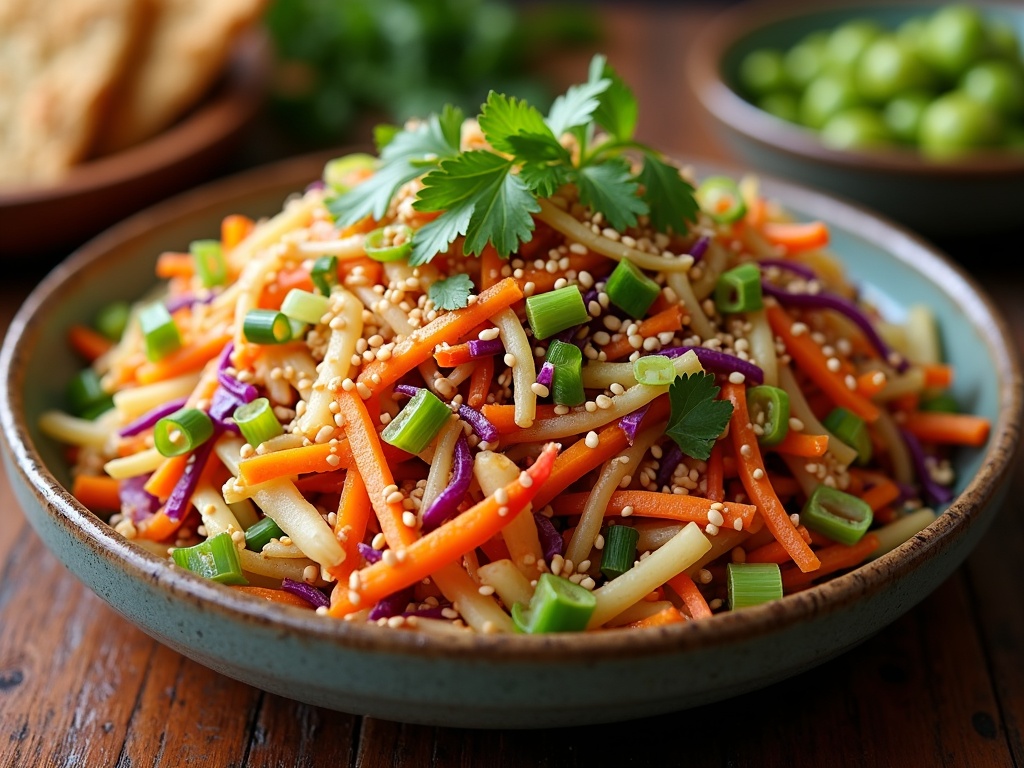
Creating The Perfect Asian Dressing
The soul of any memorable Asian slaw lies in its dressing. I’ve found that a well-crafted Asian dressing transforms simple shredded vegetables into a flavor explosion that keeps everyone coming back for seconds. The key is balancing tangy, sweet, savory, and umami notes to create harmony in every bite.
Essential Ingredients
Rice vinegar serves as the foundation of any authentic Asian dressing. Unlike western vinegars, it offers a milder, slightly sweet acidity that doesn’t overwhelm the palate. I always reach for unseasoned rice vinegar as it gives me better control over the final flavor profile.
Toasted sesame oil is non-negotiable when crafting an Asian dressing. Just a small amount delivers that distinctive nutty aroma that instantly signals “Asian flavor.” Be careful not to add too much—a little goes a long way with this potent ingredient.
Soy sauce contributes the umami depth that elevates the entire dressing. For a gluten-free option, I often substitute with tamari, which offers similar rich flavors. If you’re watching sodium intake, low-sodium soy sauce works perfectly without compromising taste.
For sweetness, I alternate between honey and maple syrup depending on what I have on hand. While honey provides a floral sweetness, maple syrup adds complexity to Asian slaws with its caramel notes. Either way, this sweetness balances the acidity from the vinegar.
Fresh ginger brings a zingy, aromatic heat that’s impossible to replicate with dried alternatives. I grate it finely using a microplane to release its oils and ensure even distribution throughout the dressing. For maximum flavor, I don’t peel young ginger with thin skin.
Minced garlic adds another layer of pungent goodness. I crush it first with the side of my knife before mincing to release more of its essential oils. One clove is usually sufficient for a standard batch of dressing.
Finally, a neutral oil like vegetable or canola creates the right consistency while allowing the other flavors to shine. I typically use a 1:1 ratio with the rice vinegar as my starting point, adjusting based on personal preference.
Perfecting Your Technique
The magic happens in how you combine these ingredients. Here are my tried-and-true techniques for creating the perfect Asian dressing:
- Dissolve the sweetener in the rice vinegar first to ensure even distribution
- Add minced aromatics (ginger and garlic) next to infuse their flavors
- Whisk in soy sauce and sesame oil
- Slowly drizzle in the neutral oil while whisking continuously for emulsion
- Let the dressing sit for at least 15 minutes before using to allow flavors to meld
I’ve found that making the dressing a day ahead results in even better flavor development. Store it in an airtight container in the refrigerator for up to a week, which makes preparing fresh Asian slaws a breeze on busy weeknights.
For an extra flavor boost, consider these optional additions:
- A squeeze of fresh lime juice for brightness
- Finely chopped cilantro for herbal notes
- Crushed red pepper flakes for heat
- A dash of fish sauce for deeper umami (use sparingly)
- Toasted sesame seeds for texture
The beauty of this dressing lies in its versatility. Beyond slaws, it makes an excellent marinade for chicken, a dipping sauce for homemade gyoza, or even a flavor enhancer for fried rice dishes. Once you master this basic formula, you’ll find countless ways to incorporate it into your Asian-inspired cooking.
Remember that the perfect Asian dressing should coat your slaw ingredients without drowning them. Start with less than you think you need, toss thoroughly, and add more gradually until you reach your desired flavor intensity.
How to Put It All Together
Creating the perfect Asian slaw is all about bringing together fresh, vibrant ingredients and allowing the flavors to meld beautifully. I’ve found that assembly timing and technique make a noticeable difference in the final result.
Assembly Process
The first step is combining all your sliced vegetables in a large mixing bowl. I like to use a bowl with plenty of room for tossing to ensure even distribution of ingredients. The colorful medley of cabbage, carrots, bell peppers, and any other vegetables you’ve chosen creates a stunning visual appeal that’s part of what makes Asian-inspired salads so special.
Next, grab a separate smaller bowl to whisk together your dressing ingredients. This separation is crucial—it allows you to fully emulsify the dressing before introducing it to the vegetables. Thoroughly whisk the rice vinegar, sesame oil, soy sauce, and other seasonings until they’re completely integrated.
Once your dressing is ready, pour it over the vegetable mixture in the large bowl. I recommend starting with about three-quarters of the dressing, as you can always add more but can’t take it away. Using tongs or two large spoons, gently toss the slaw to coat every piece with the flavorful dressing. The goal is even distribution without crushing or bruising the vegetables.
After tossing, let the slaw sit for about 15 minutes before serving. This resting period is crucial as it allows the vegetables to slightly soften and absorb the delicious Asian flavors. The cabbage will maintain its crunch while taking on the delightful tangy-sweet notes from the dressing.
Just before serving, sprinkle your chosen nuts and seeds over the top—toasted sesame seeds, sliced almonds, or crushed peanuts add a wonderful textural contrast and nutty flavor that elevates the entire dish. For extra visual appeal and flavor, I sometimes add a final garnish of fresh herbs like cilantro or Thai basil and a squeeze of lime juice for brightness.
The beauty of this Asian-inspired dish is its versatility—serve it immediately for maximum crunch or let it marinate longer for deeper flavor development.
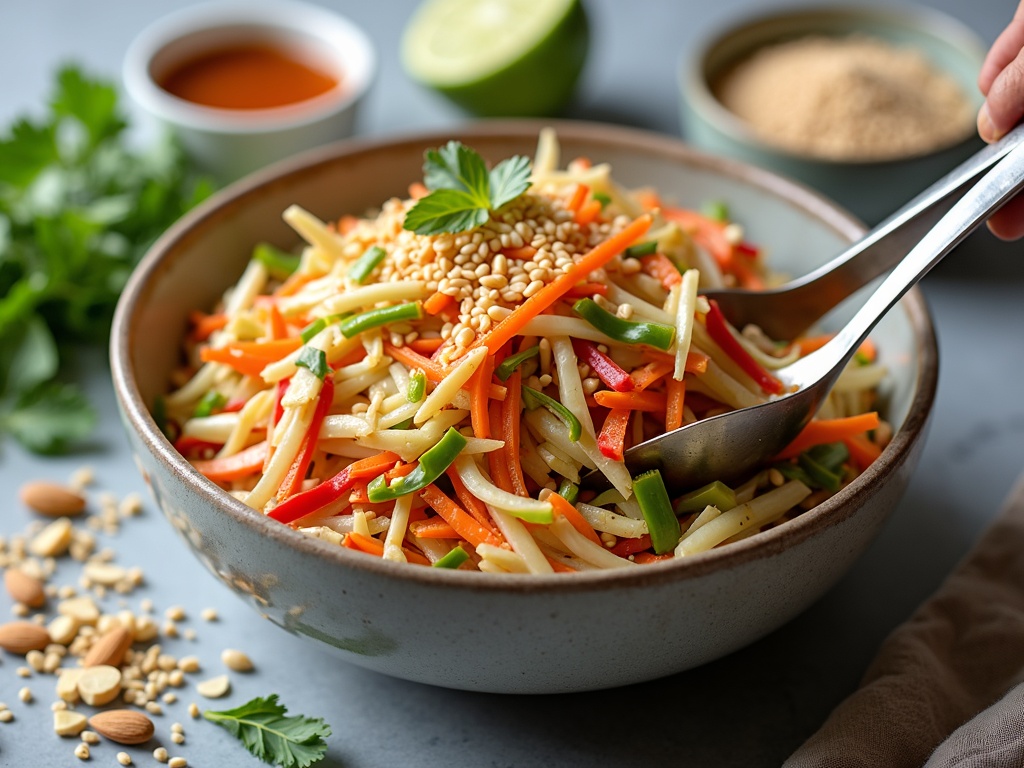
Common Mistakes to Watch For
Making an Asian-inspired slaw seems straightforward, but there are several pitfalls that can turn your crunchy masterpiece into a soggy disappointment. I’ve made these mistakes myself in the past, and I’m sharing them so you can create the perfect slaw every time.
Culinary Pitfalls to Avoid
First on my list is using old, wilted vegetables. Fresh produce is the foundation of any good slaw. When cabbage, carrots, or bell peppers have lost their crispness, your slaw will lack that signature crunch that makes it so appealing. I always check my vegetables for firmness and vibrant color before chopping. If your cabbage feels soft or your carrots are bendable, it’s time to get fresh ones.
Another common error is drowning your slaw in dressing. I’ve learned that adding too much dressing at once creates a swimming pool at the bottom of your bowl. The vegetables release their moisture over time, which combines with the dressing to create excess liquid. Instead, I start with half the amount of dressing I think I’ll need, toss everything thoroughly, then add more gradually until it’s just right. You can always enhance the flavors by adding more dressing later, but you can’t take it away once it’s mixed in.
Skipping the resting time is a mistake I used to make regularly. Allowing your slaw to rest for at least 30 minutes helps the flavors meld together beautifully. The vegetables slightly soften while maintaining their crunch, and the dressing infuses every piece with flavor. For best results, I make my slaw a few hours before serving and keep it in the refrigerator.
Inconsistent cutting is another issue that affects both texture and visual appeal. When vegetables are cut in different sizes and shapes, they don’t blend well together, and some pieces might be too large to eat comfortably. I use a sharp knife or mandoline to ensure uniform cuts. Thin, matchstick pieces work best for carrots and peppers, while cabbage benefits from a fine shred. This consistency creates a harmonious blend of textures in every bite.
Finally, forgetting to season to taste is perhaps the biggest mistake of all. Many home cooks follow recipes exactly without considering personal preference or ingredient variations. I always taste my slaw before serving and adjust the seasoning as needed. Sometimes it needs more salt, a splash of vinegar for acidity, a bit of honey for sweetness, or even an extra squeeze of lime to brighten the flavors.
Quick Fixes for Common Slaw Problems
Here are some quick fixes for common slaw problems:
- If your slaw is too dry: Add a small amount of additional dressing and toss well.
- If your slaw is too wet: Add more fresh vegetables or a handful of toasted nuts for crunch.
- If flavors are bland: Try adding fresh herbs like cilantro or mint, a squeeze of citrus, or a dash of flavorful spices.
- If it’s too spicy: Balance with a touch of honey or a dollop of yogurt.
- If it’s too sweet: Add a splash of rice vinegar or lime juice.
The beauty of Asian-inspired dishes like slaw is their flexibility. Once you understand these common pitfalls, you can create a vibrant, crunchy side dish that complements everything from grilled meats to noodle dishes. Each mistake is really just an opportunity to learn and improve your culinary skills.
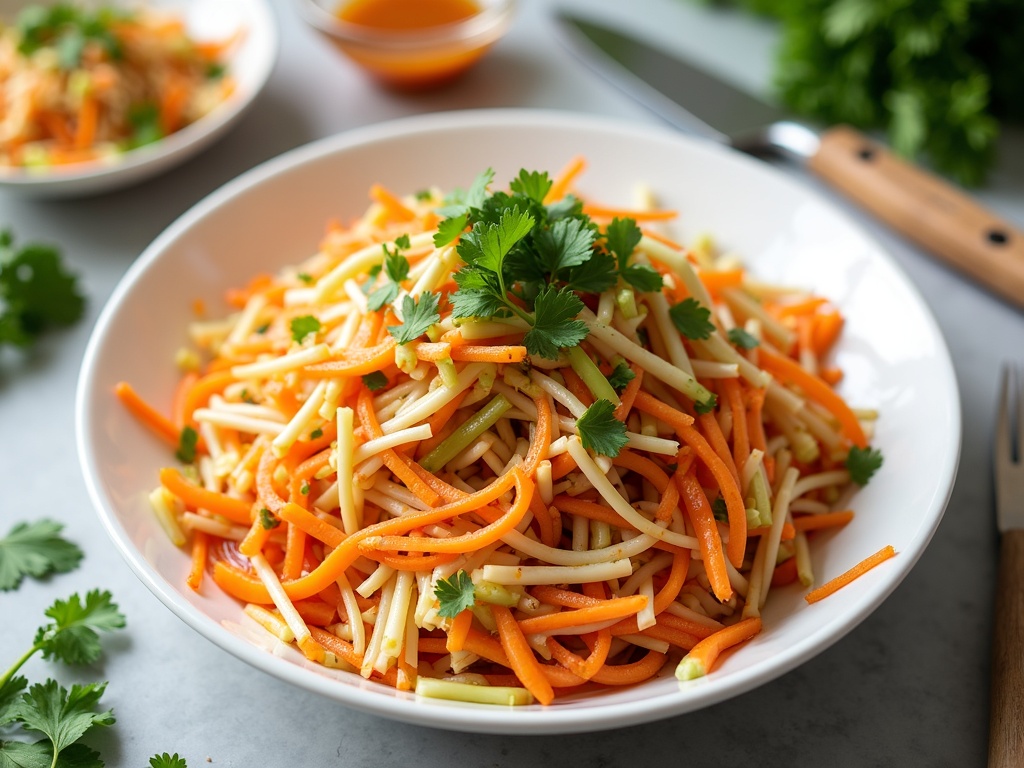
Helpful Tips for Success
Making Asian-inspired slaw recipes doesn’t have to be complicated. I’ve discovered a few tricks that’ll help you achieve perfect results every time.
Time-Saving Preparation Strategies
Prep work can make or break your slaw experience. I always chop my vegetables ahead of time and store them separately in airtight containers in the fridge. This simple step saves precious minutes when I’m rushing to get dinner on the table. Cabbage, carrots, and bell peppers can be prepped up to 3 days in advance without losing their crunch.
The dressing is the heart of any good Asian slaw. I typically make double batches of my slaw dressing and keep the extra in the refrigerator. This makes it easy to whip up a fresh batch of slaw later in the week or to refresh leftovers that have lost some zing.
Before combining everything, I taste and adjust the seasonings in my dressing. Asian slaws often need a careful balance of sweet, sour, salty, and spicy elements. Don’t hesitate to add more lime juice for acidity, honey for sweetness, or Thai chili for heat until it’s just right.
For the crispest results, I store the chopped vegetables and dressing separately until serving time. This prevents the slaw from becoming soggy. If you’re taking this to a gathering, pack the components separately and toss them together just before serving.
While some salads improve with time, Asian slaw is at its prime within 24 hours of mixing. The vegetables stay crisp, and the flavors meld beautifully in this window. After that, the texture starts to soften as the vegetables release their moisture into the dressing.
When serving, I often garnish with toasted sesame seeds, chopped fresh herbs, or crushed peanuts right before bringing it to the table. These final touches add texture and visual appeal that elevate the whole dish.
Serving Suggestions
Asian slaw isn’t just a side dish – it’s a versatile accompaniment that can transform ordinary meals into extraordinary culinary experiences. I’ve discovered numerous ways to incorporate this vibrant, crunchy dish into different meal settings, making it a staple in my kitchen repertoire.
Perfect Pairings and Creative Serving Ideas
This colorful slaw makes an exceptional companion to grilled meats. The tangy, refreshing qualities of Asian slaw create a beautiful contrast when served alongside smoky grilled beef or chicken. The acidity helps cut through the richness of the meat, while the crunch adds a textural element that elevates the entire meal.
For seafood lovers, Asian slaw works wonders in fish tacos. The bright flavors and crisp texture complement the delicate fish perfectly. I simply spoon some slaw onto warm tortillas, add grilled or fried fish, and finish with a drizzle of sriracha mayo for a quick yet impressive meal that feels both casual and sophisticated.
Looking for a light but satisfying lunch option? Asian slaw can stand on its own when topped with a protein source. Some fantastic protein additions include:
- Grilled chicken strips
- Seared tofu cubes
- Poached or boiled shrimp
- Sliced pan-seared gyoza
- Thinly sliced beef
Buddha bowls have gained immense popularity in recent years, and Asian slaw fits perfectly into this healthy eating concept. I create a base of brown rice or quinoa, add a generous portion of Asian slaw, and top with roasted vegetables, a protein source, and perhaps some avocado slices. A drizzle of peanut sauce ties everything together beautifully, creating a nutritionally balanced meal that’s both satisfying and visually appealing.
The portable nature of Asian slaw makes it ideal for social gatherings. It travels well to potlucks and picnics since it doesn’t wilt quickly like traditional lettuce-based salads. Unlike mayo-based slaws that require constant refrigeration, many Asian slaw dressings are vinegar-based, making them more food-safe for outdoor events. I often bring a large bowl of colorful Asian slaw to gatherings, and it’s consistently one of the first dishes to disappear.
For an easy weeknight dinner, I sometimes use Asian slaw as a bed for quick stir-fried proteins. The warm components slightly wilt the slaw, creating an interesting textural contrast. This approach works particularly well with leftover Chinese fried rice or other Asian-inspired dishes.
Another creative way to serve Asian slaw is as a topping for fusion-style burgers or sandwiches. The crunch and tang add dimension to these handheld meals. I particularly enjoy adding it to shredded adobo sandwiches for a Filipino-inspired treat.
For a refreshing summer dinner, I serve Asian slaw alongside classic pad Thai or other noodle dishes. The cool, crisp slaw provides a welcome contrast to warm, spicy noodles.
Asian slaw is remarkably versatile – it can be dressed up for elegant dinner parties or kept casual for everyday meals. Its vibrant colors, crunchy texture, and bold flavors make it more than just a side dish – it’s a versatile component that can enhance countless meals in surprising and delightful ways.
Storage and Make-Ahead Tips
I’ve found that Asian slaw is one of those versatile dishes that can be prepped ahead of time, making it perfect for meal planning or entertaining. With a few simple storage strategies, you can maintain that crisp texture and vibrant flavor that makes Asian-inspired recipes so appealing.
Keeping Components Separate
The key to longer-lasting slaw is storing the components separately until just before serving:
- Place shredded vegetables in an airtight container lined with paper towels to absorb excess moisture
- Store your prepared dressing in a small jar or container with a tight-fitting lid
- Keep any crunchy toppings like nuts, seeds, or crispy noodles in separate containers to prevent sogginess
- Refrigerate all components until ready to combine
This separation method preserves the freshness of each ingredient. When stored properly, the undressed vegetables maintain their crispness, while the dressing stays vibrant and flavorful. I’ve successfully kept my cabbage and vegetable mix fresh for up to 3-4 days using this technique.
For maximum convenience, I often prep all the vegetables 2-3 days before I need them. The time-consuming part of making fresh Asian salads is the chopping and slicing, so completing this step in advance is a real time-saver.
Working with Dressed Slaw
If you’ve already combined your slaw with dressing, don’t worry – it can still be stored and enjoyed later:
Dressed Asian slaw generally keeps well for 1-2 days in the refrigerator. After this time, the vegetables begin to soften and release water, which can make the slaw soggy. For best results, I recommend consuming dressed slaw within 24 hours.
When storing dressed slaw, make sure to use a container with a tight-fitting lid to prevent odors from transferring between foods in your refrigerator. Asian slaw dressings often contain ingredients like aromatic sesame oil and garlic that can easily permeate other foods.
I’ve noticed that some vegetables hold up better than others when dressed. Hearty vegetables like cabbage, carrots, and bell peppers maintain their texture longer than delicate greens or herbs, which tend to wilt quickly once dressed.
For the best flavor and texture, I always serve my Asian-inspired dishes like slaw properly chilled. The cool temperature enhances the refreshing quality of the dish and allows the flavors to fully develop.
If you’re bringing Asian slaw to a potluck or outdoor gathering, keep it in a cooler with ice packs until serving time. This maintains food safety and preserves that delightful crisp texture that makes Asian slaw so appealing.
Remember that dressed slaw will continue to soften over time as the vegetables release water and absorb the dressing. If you prefer a crunchier texture, consider dressing only the portion you plan to eat immediately and saving the rest for later.
Whether you’re meal prepping for the week or preparing for a special gathering, these storage tips will help ensure your Asian-inspired sides stay fresh and delicious from preparation to serving.

